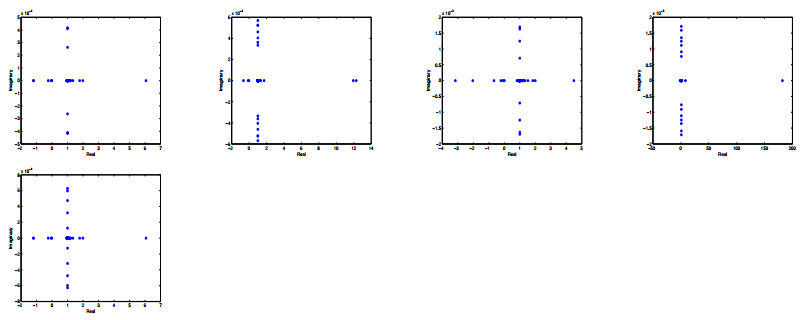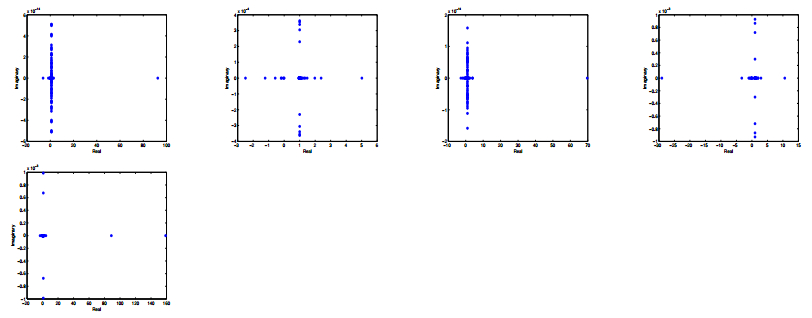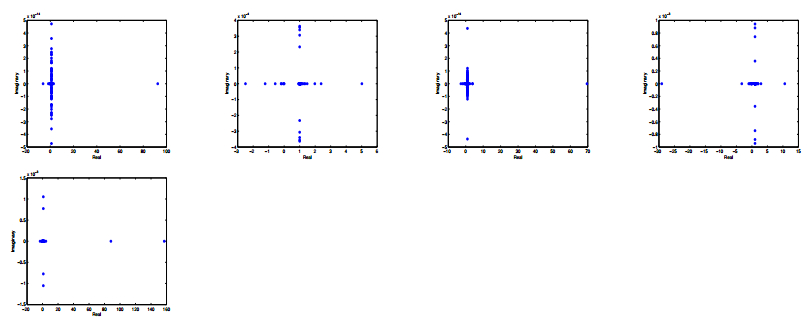Recently, Chen and Ma [A generalized shift-splitting preconditioner for saddle point problems, Applied Mathematics Letters, 43 (2015) 49-55] introduced a generalized shift-splitting preconditioner for saddle point problems with symmetric positive definite (1, 1)-block. In this paper, I establish a parameterized shift-splitting preconditioner for solving the large sparse augmented systems of linear equations. Furthermore, the preconditioner is based on the parameterized shift-splitting of the saddle point matrix, resulting in an unconditional convergent fixed-point iteration, which has the intersection with the generalized shift-splitting preconditioner. In final, one example is provided to confirm the effectiveness.
1.
Introduction
The well-known classical Lyapunov inequality [15] states that, if u is a nontrivial solution of the Hill's equation
subject to Dirichlet-type boundary conditions:
then
where q:[a,b]→R is a real and continuous function.
Later, in 1951, Wintner [24], obtained the following inequality:
where q+(t)=max{q(t),0}.
A more general inequality was given by Hartman and Wintner in [12], that is known as Hartman Wintner-type inequality:
Since maxt∈[a,b](t−a)(b−t)=(b−a)24, then, (1.5) implies (1.4).
The Lyapunov inequality and its generalizations have many applications in different fields such in oscillation theory, asymptotic theory, disconjugacy, eigenvalue problems.
Recently, many authors have extended the Lyapunov inequality (1.3) for fractional differential equations [1,2,3,4,5,6,7,8,9,10,11,12,13,15,18,20,22,23,24]. For this end, they substituted the ordinary second order derivative in (1.1) by a fractional derivative or a conformable derivative. The first result in which a fractional derivative is used instead of the ordinary derivative in equation (1.1), is the work of Ferreira [6]. He considered the following two-point Riemann-Liouville fractional boundary value problem
And obtained the Lyapunov inequality:
Then, he studied in [7], the Caputo fractional differential equation
under Dirichlet boundary conditions (1.2). In this case, the corresponding Lyapunov inequality has the form
Later Agarwal and Özbekler in [1], complimented and improved the work of Ferreira [6]. More precisely, they proved that if u is a nontrivial solution of the Riemann-Liouville fractional forced nonlinear differential equations of order α∈(0,2]:
satisfying the Dirichlet boundary conditions (1.2), then the following Lyapunov type inequality
holds, where p, q, f are real-valued functions, 0<γ<1<μ<2, μ0=(2−μ)μμ/(2−μ)22/(μ−2) and γ0=(2−γ)γγ/(2−γ)22/(γ−2).
In 2017, Guezane-Lakoud et al. [11], derived a new Lyapunov type inequality for a boundary value problem involving both left Riemann-Liouville and right Caputo fractional derivatives in presence of natural conditions
then, they obtained the following Lyapunov inequality:
Recently, Ferreira in [9], derived a Lyapunov-type inequality for a sequential fractional right-focal boundary value problem
where 0<α,β,γ≤1, 1<α+β≤2, then, they obtained the following Lyapunov inequality:
where
Note that more generalized Lyapunov type inequalities have been obtained for conformable derivative differential equations in [13]. For more results on Lyapunov-type inequalities for fractional differential equations, we refer to the recent survey of Ntouyas et al. [18].
In this work, we obtain Lyapunov type inequality for the following mixed fractional differential equation involving both right Caputo and left Riemann-Liouville fractional derivatives
satisfying the Dirichlet boundary conditions (1.2), here 0<β≤α≤1, 1<α+β≤2, CDαb− denotes right Caputo derivative, Dβa+ denotes the left Riemann-Liouville and q is a continuous function on [a,b].
So far, few authors have considered sequential fractional derivatives, and some Lyapunov type inequalities have been obtained. In this study, we place ourselves in a very general context, in that in each fractional operator, the order of the derivative can be different. Such problems, with both left and right fractional derivatives arise in the study of Euler-Lagrange equations for fractional problems of the calculus of variations [2,16,17]. However, the presence of a mixed left and right Caputo or Riemann-Liouville derivatives of order 0<α<1 leads to great difficulties in the study of the properties of the Green function since in this case it's given as a fractional integral operator.
We recall the concept of fractional integral and derivative of order p>0. For details, we refer the reader to [14,19,21]
The left and right Riemann-Liouville fractional integral of a function g are defined respectively by
The left and right Caputo derivatives of order p>0, of a function g are respectively defined as follows:
and the left and right Riemann-Liouville fractional derivatives of order p>0, of a function g\ are respectively defined as follows:
where n is the smallest integer greater or equal than p.
We also recall the following properties of fractional operators. Let 0<p<1, then:
1- IpCa+Dpa+f(t)=f(t)−f(a).
2- IpCb−Dpb−f(t)=f(t)−f(b).
3- (Ipa+c)(t)=c(t−a)pΓ(p+1),c∈R
4- Dpa+u(t)=CDpa+u(t), when u(a)=0.
5- Dpb−u(t)=CDpb−u(t), when u(b)=0.
2.
Lyapunov inequality
Next we transform the problem (1.6) with (1.2) to an equivalent integral equation.
Lemma 1. Assume that 0<α,β≤1. The function u is a solution to the boundary value problem (1.6) with (1.2) if and only if u satisfies the integral equation
where
is the Green's function of problem (1.6) with (1.2).
Proof. Firstly, we apply the right side fractional integral Iαb− to equation (1.6), then the left side fractional integral Iβa+ to the resulting equation and taking into account the properties of Caputo and\Riemann-Liouville fractional derivatives and the fact that Dβa+u(t)=CDβa+u(t), we get
In view of the boundary condition u(b)=0, we get
Substituting c in (2.3), it yields
Finally, by exchanging the order of integration, we get
thus
with
that can be written as
Conversely, we can verify that if u satisfies the integral equation (2.1), then u is a solution to the boundary value problem (1.6) with (1.2). The proof is completed.
In the next Lemma we give the property of the Green function G that will be needed in the sequel.
Lemma 2. Assume that 0<β≤α≤1,1<α+β≤2, then the Green function G(t,r) given in (2.2) of problem (1.6) with (1.2) satisfies the following property:
for all a≤r≤t≤b.
Proof. Firstly, for a≤r≤t≤b, we have G(t,r)≥0. In fact, we have
in addition,
Thus, from (2.4) and (2.5), we get
where
it is clear that h(s)≥0, for all s∈[a,b].
Now, for a≤t≤r≤b, we have
On the other hand,
since β≤α, we get
From (2.7) and (2.8) we obtain
Finally, by differentiating the function h, it yields
We can see that h′(s)=0 for s0=a+α(b−a)(β+α)∈(a,b), h′(s)<0 for s>s0 and h′(s)>0 for s<s0. Hence, the function h(s) has a unique maximum given by
From (2.6) and (2.9), we get |G(t,r)|≤h(s0), from which the intended result follows.
Next, we state and prove the Lyapunov type inequality for problem (1.6) with (1.2).
Theorem 3. Assume that 0<β≤α≤1 and 1<α+β≤2. If the fractional boundary value problem (1.6) with (1.2) has a nontrivial continuous solution, then
Proof. Let X=C[a,b] be the Banach space endowed with norm ||u||=maxt∈[a,b]|u(t)|. It follows from Lemma 1 that a solution u∈X to the boundary value problem (1.6) with (1.2) satisfies
Now, applying Lemma 2 to equation (2.1), it yields
Hence,
from which the inequality (2.10) follows. Note that the constant in (2.10) is not sharp. The proof is completed.
Remark 4. Note that, according to boundary conditions (1.2), the Caputo derivatives CDαb− and CDβa+ coincide respectively with the Riemann-Liouville derivatives Dαb− and Dβa+. So, equation (1.6) is reduced to the one containing only Caputo derivatives or only Riemann-Liouville derivatives, i.e.,
or
Furthermore, by applying the reflection operator (Qf)(t)=f(a+b−t) and taking into account that QCDαa+=CDαb−Q and QCDβb−=CDβa+Q (see [21]), we can see that, the boundary value problem (1.6) with (1.2) is equivalent to the following problem
Remark 5. If we take α=β=1, then the Lyapunov type inequality (2.3) is reduced to
Acknowledgements
The authors thank the anonymous referees for their valuable comments and suggestions that improved this paper.
Conflict of interest
All authors declare no conflicts of interest in this paper.
















 DownLoad:
DownLoad: